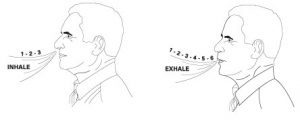An effective and easy way to help manage stress and pain is to breathe! Yes, we are already doing this approximately 20,000 times a day; however, we are not always performing it optimally. Just a minute a day spent practicing controlled breathing can help teach our body to breathe in a more efficient manner, which will help to decrease pain and manage stress.
How Will Breathing Help?
- It will help calm the nervous system.
Controlled breathing can help to shift our body from a more sympathetic state (Fight or Flight) to a more parasympathetic state (Rest-Relaxation). When we are stressed or in pain, our bodies are in an overdrive or sympathetic state. If we take deep controlled full breaths we can help calm the nervous system.
- It will help balance the muscular effort of the breathing muscles and take pressure off the ones that are doing more work.
Many people will predominantly use their upper chest when breathing instead of their full trunk to create rib cage expansion to bring in oxygen. This puts more strain on our secondary muscles of respiration (most notably the neck muscles). These muscles are generally tight and sore from hours sitting at a desk, driving in a car, and time spent looking at our phones. The last thing we want is to have our already tight neck muscles do more work to allow us to breathe.
Performing Controlled Breathing
- Lay on your back with your knees bent and feet flat on the floor. Place one hand on your stomach and one hand on your upper chest (below your collarbones). Note: you can do this seated as well.
- Inhale through your NOSE, focusing on filling your abdomen, followed by your ribs and then your upper chest with air. You should feel your hand placed on your stomach rise first and then your hand on your upper chest to rise last.
- Exhale through your MOUTH until you feel that all of the air has emptied. Take double the amount of time to exhale as you did to inhale. For example, take three to five seconds to inhale and six to ten seconds to exhale. You want to feel your abdominal muscles engage as you fully exhale.
- Repeat these steps five (5) times. You should feel like you become more relaxed and that your pain decreases.
This is a great exercise to do daily any time that you are feeling stressed, feeling a lot of neck tension, low back pain or even after a workout.

